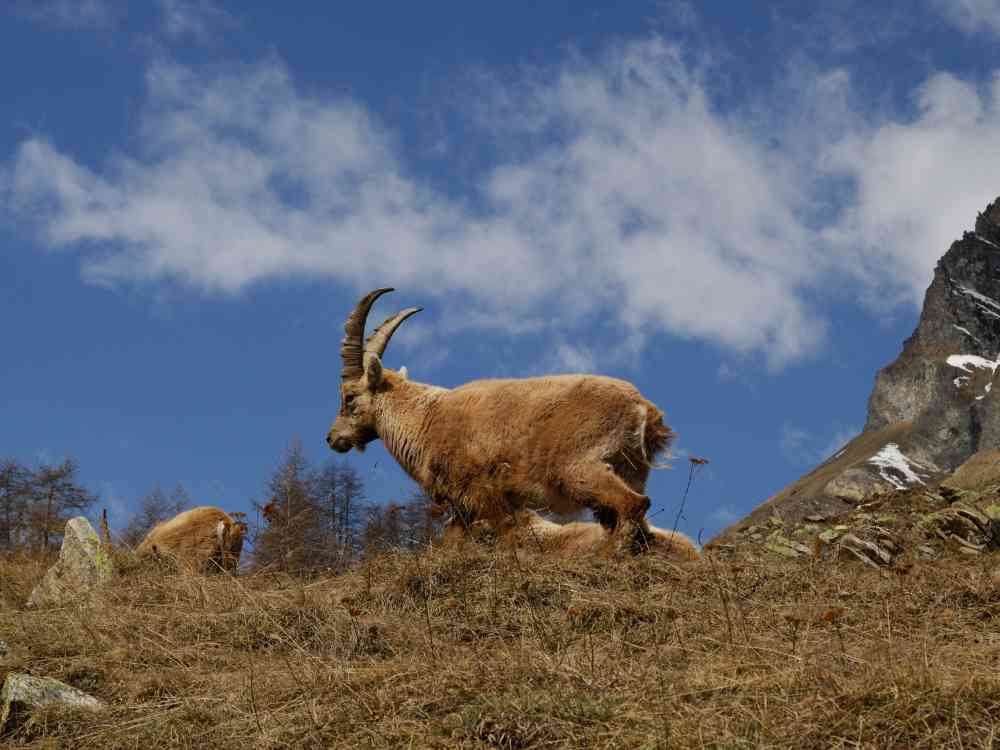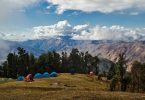Imagine a vast parched expanse leading you into valleys of brown jagged mountains towering over a still blue lake right at its heart. What a sight to behold! Isn’t it? I am sure you are waiting for the right time to backpack in Ladakh. And while you let time pass in your little cubicles, there are some friends who get to dwell in the arid landscapes of Ladakh. The wildlife of Ladakh is one to appreciate and capture. A trip to Ladakh is not all-terrain though, the desolate regions are thatched with green pastures near its pristine lakes. These stunning lakes of Ladakh while being the perfect location to stop by, also give life to Ladakh’s flora and fauna. The lands of high passes shelter a dandy array of wildlife, here we share some of the rare sightings and some you can pet, skim through to know which fur friends you get a chance to greet on our Ladakh backpacking trip.
The Unique Wildlife of Ladakh
Snow Leopards
We begin with the life of Ladakh winter expeditions, snow leopards or Rchan as the Ladakhi call them are one of the most beautiful wild cats. Though not a suitable time to visit Ladakh, you can spot these snow leopards in the peak freezing winters of Ladakh. Due to the dwindling snow leopard population, they are listed to be rare in the IUCN Red List of Endangered Animals. Found in the toughest most rocky outcrops of Ladakh in the summers, they simply follow their vegan prey to the lower elevations where vegetation is still present for grazing. The mighty wild cats of Ladakh love to hunt down Asiatic ibex as well as Bharal (Himalayan blue sheep)
- Ladakhi name: Rchan
- Spotting locations: Hemis National Park, Rumbak Valley and Zanskar Valley

Eurasian Lynx
This cat species is rare to find and not the kind you’d pet. Lynx is a carnivores wolf-like cat, found in the mountainous regions of Ladakh and Kashmir. Spotted in fur coats of tan, grey to reddish brown, these animals are rare to find and are secretive too. Thanks to their muscular build and strong limbs, they are excellent climbers and prey on Tibetan hares, pikas and tiny marmots. The Eurasian lynx are loners and help maintain the ecosystem by curbing the population of the little prey animals.
- Local Name: Eeh
- Spotting locations: Changthang Wildlife Sanctuary, Tso-Kar Basin, Hemis National Park, Nubra Valley

Asiatic Ibex
These beautiful herbivores have long arched brown horns. Asiatic Ibex is considered to be a sub-species of the Siberian Ibex. They move in herds and usually dwell in alpine meadows perfect for grazing however they descend to the settlements in the freezing winters in search of grassy patches and less snow. These beauties usually lie low during the day and forage for grass and twigs around sunrise and sunset to avoid predation, winter snowpack and any human activity. There is a strong possibility of you passing by these wild goats grazing with their flock.
- Local Name: Skin
- Spotting locations: Kanji near Lamayuru, Changla, and Nubra Shayok valleys

Ladakh Urial
These red sheep are a common sighting in Ladakh. Horns curved to the back these are the most petite of all the wild sheep. They dwell in herds and are found living in the vegetative patches of the mountains or steep spots. Even so, they live comparatively in the lower belts for easier forage. The dainty-looking urials are challenged by the predators in the mountains as well as human settlements in the plains as they are hunted down due to their tendency to cause harm to the crops. Leaving them to find home in sub-optimal regions of the valleys.
- Local Name: Shapo
- Spotting Locations: Fotu La, Near Lamayuru, and the valleys of Indus and Shyok

Read why the Ladakh bike trip offers you the best Ladakh experience.
Black-Necked Crane
The black-necked cranes are migratory birds in Ladakh that are found in the Tibetan region and the Himalayas. The chances of sighting black-necked cranes en route Tso Moriri and Tso Kar Lake are quite probable. These birds are the most anticipated sighting of the flora and fauna of Ladakh and are commonly spotted when they arrive by March end to April. They begin the process of courtship and finally mate with their partners after luring them by flapping their wings and dancing. You can quietly take a picture of these rare birds as they are often seen around a herd of Kiangs and Yaks or foraging near livestock proving their comfort around human settlements.
- Local Name: Cha Thung Thung
- Spotting Locations: Shores of famous Ladakh Lakes, Tso Moriri, Tso Kar

Himalayan Marmot
You can spot the Himalayan marmots running around in the barren terrains, their plump limbs and short tails will surely leave you gushing over. They feed on grass, roots, and other other greens available, so please do not feed them biscuits on your encounter. They forage extensively in late summers to store the fat in their bodies and hibernate in their deep burrows for at least 6 months of the harsh winter. These little animals look endearing when they stand on their hinds although the stance symbolises observation while they scream when in danger approaches. .
- Local Name: Phiya
- Spotting Locations: Leh, Nubra Valley, Pangong Tso and Changthang Wildlife Sanctuary in Ladakh

Suggested read: The Perfect Time to Visit Leh Ladakh
Tibetan Wild Ass
Herds of the majestic kiang, or Tibetan wild ass can be seen throughout the landscapes of Ladakh. With their reddish-brown backs, massive heads, and strong, muscular bodies, kiangs roam freely across the open grasslands of Ladakh, often spotted near the serene Tso Moriri and Tso Kar lakes. Driving through Ladakh, these equids might first appear like a cross between horses and donkeys boasting a dark-brown mane, large ears tipped in black, and a robust stature that outmatches typical donkeys. Despite their imposing presence, kiangs are surprisingly agile, often seen galloping across the plains with an effortless grace. The animals are natural foragers, grazing on the alpine grasses and sedges that carpet their high-altitude home—observing them in their natural habitat.
- Local Name: Kiang
- Spotting Locations: Hanle, Tso Kar, and Changthang Wildlife Sanctuary in Ladakh

Double-Humped Bactrian Camel
These majestic Ladakh animals were once the resilient backbone of the ancient Silk Road, which now captivates tourists with camel safaris across the white sand dunes of Hunder and along the picturesque Shyok River. Your Ladakh itinerary can include riding the sturdy backs of the camels offering a unique experience into the bygone era, making for an unforgettable adventure amidst Ladakh’s breathtaking landscapes. Abandoned by traders, these camels found a new home in Nubra Valley. Today, these camels are not only one of the top tourist attractions in Ladakh but also a vital part of the local economy, providing livelihoods through camel safaris. Tourists riding these camels should be aware of their plight and support sustainable tourism practices.
- Spotting Locations: Hunder Sand Dunes, Nubra Valley

Get to ride on a Double Humped Camel and much more with JustWravel’s Ladakh Tour Packages.
While you venture into the raw beautiful vistas of Ladakh, remember that each encounter with its incredible wildlife is a privilege. From the majestic snow leopards to the charming double-humped Bactrian camels, these animals enrich the experience of exploring this high-altitude haven. However, with this privilege comes the responsibility to be kind and considerate visitors. Ensure you practice sustainable tourism in Ladakh by respecting the habitats of these remarkable Ladakh animals, maintaining a safe distance, and avoiding any actions that might disturb their natural behaviours.
By being mindful stewards of Ladakh’s fragile ecosystem, we can help protect these animals found in Ladakh and their environment, ensuring that future generations of travellers can also revel in the wonders of the wildlife of Ladakh. Let’s cherish every moment, and exchange only footprints with memories, as we preserve the magic of Ladakh animals for years to come.
FAQs
What is the famous wildlife of Ladakh?
Ladakh is renowned for its unique and diverse wildlife, particularly the elusive snow leopard, often referred to as the “ghost of the mountains.” Other notable species include the Tibetan antelope (chiru), Himalayan blue sheep (bharal), Ladakhi urial, and the black-necked crane, which migrates to the region during the summer.
What are the two wildlife sanctuaries in Ladakh?
Ladakh is home to several protected areas, with Hemis National Park and Changthang Wildlife Sanctuary being the most prominent. Hemis National Park is famed for its snow leopard population, while Changthang Wildlife Sanctuary protects a variety of high-altitude species, including the Tibetan wild ass (kiang) and the black-necked crane.
What is the state animal of Ladakh?
The state animal of Ladakh is the snow leopard. This magnificent and elusive predator is a symbol of the region’s rich natural heritage and is a key species in the cold desert ecosystem of Ladakh.
Which are the main animals of the Ladakh region?
The main animals of the Ladakh region include the snow leopard, Tibetan antelope (chiru), Himalayan blue sheep (bharal), Ladakhi urial, Tibetan wild ass (kiang), and the black-necked crane. These species are well adapted to the harsh, high-altitude environment of Ladakh.
What is the horse-like animal in Ladakh?
The horse-like animal in Ladakh is the Tibetan wild ass, also known as the kiang. It is the largest of the wild asses and is well adapted to the cold and arid high-altitude plains of Ladakh, especially in the Changthang region.
What animals are in the Hanle?
The Hanle region, part of the Changthang Wildlife Sanctuary, is home to a variety of high-altitude wildlife. The commonly sighted are the Tibetan wild ass (kiang), Tibetan gazelle, and the black-necked crane. The area also provides a habitat for various migratory birds and other endemic species.
Explore the majestic Ladakh and spot these wildlife on your next adventure!!







